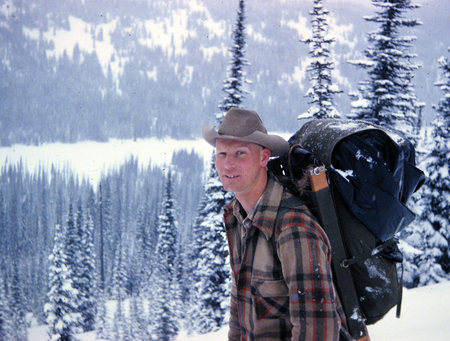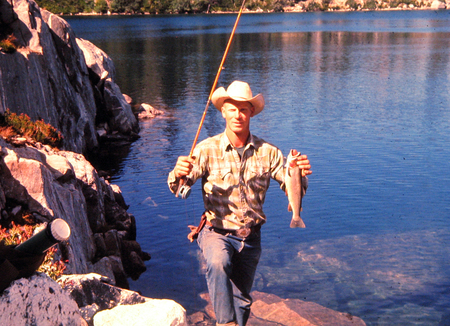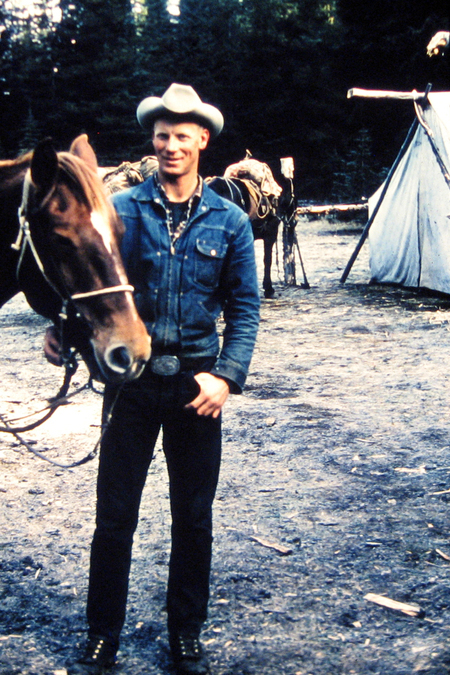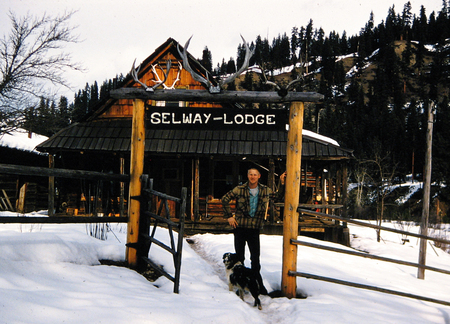Episode 2 : Encounters With Animals in the Selway-Bitterroot Wilderness: an interview with Jim Renshaw Item Info
In this episode, titled “Encounters with Animals in the Selway-Bitterroot Wilderness,” Jim Renshaw remembers a life spent as a packer and outfitter in the Selway-Bitterroot Wilderness and the animals that shared a livelihood with him there.
In 1931 Alvin Renshaw and his wife bought the Pettibone Ranch, which was later renamed Selway Lodge, near the mouth of Bear Creek along the Selway River and just a mile and a half from what would later become Shearer Guard Station. In 1932 Alvin, his wife, and their three small children made their new home deep within what is now the Selway-Bitterroot Wilderness. Jim was just two months old at the time. For the next sixteen years the Renshaw family made their living as outfitters, hosting numerous guests from all over the country at the Selway Lodge. Although Alvin sold the business and lodge in 1948, his son Jim began packing for the new owners of the Selway Lodge. Jim later bought an old homestead at Trout Creek, near Three Forks in the Moose Creek drainage, where he and his wife operated an outfitting business in the wilderness. Jim officially retired in 1998, but continues to pack for volunteer trail crews that go into the Selway-Bitterroot yearly for trail maintenance.
Episode 2 : Encounters With Animals in the Selway-Bitterroot Wilderness: an interview with Jim Renshaw [transcript]
00:00:00:00 - 00:00:29:20 Debbie Lee or Jane Holman: Welcome to the Selway Bitterroot Wilderness History Project, which is made possible by a grant from the National Endowment for the Humanities. The University of Idaho, and Washington State University. Part of the project’s mission is to collect, preserve, and make public oral histories documenting the history and people of the Selway Bitter Wilderness. For more information, please visit our website at SPW lib argue idaho.edu.
00:00:29:22 - 00:00:58:00 Debbie Lee or Jane Holman: And then I thank people. I think people get so much out of being in a wilderness setting. Once you take away cars and money and telephones. People are different and they are different to each other, I think. and, and then they draw on things in themselves that maybe are a little rusty from our crazy life out here now.
00:00:58:03 - 00:01:30:23 Debbie Lee or Jane Holman: I think the ways that people get along when they’re isolated in a place like that, that they place that they want to be, are really it’s a wonderful thing.
00:01:30:26 - 00:02:00:16 Debbie Lee or Jane Holman: Thank you for joining us for the second episode of the Selway Bitterroot Wilderness History Project. In this episode, titled encounters with animals in the South Bitterroot Wilderness, Jim Renshaw remembers a life spent as a packer and outfitter in the South Bitterroot Wilderness, and the animals that shared a livelihood with him there. In 1931, Alvin Renshaw and his wife bought the Pettibone Ranch, which was later renamed Solway Lodge, near the mouth of Bear Creek along the South River.
00:02:00:16 - 00:02:23:25 Debbie Lee or Jane Holman: In just a mile and a half from what would later become Shere Guard Station. In 1932, Alvin, his wife, and their three small children made their new home deep within what is now the South Bitterroot Wilderness. Jim was just two months old at the time. For the next 16 years, the Renshaw family made their living as outfitters, hosting numerous guests from all over the country at the Selway Lodge.
00:02:23:27 - 00:02:50:12 Debbie Lee or Jane Holman: Although Alvin sold the business and lodge in 1948, his son Jim began packing for the new owners of the Selway Lodge. Jim later bought an old homestead at Trout Creek near Three Forks in the Moose Creek drainage, where he and his wife operated an outfitting business in the wilderness. Jim officially retired in 1988, but continues to pack for volunteer trail crews that go into the South Bitterroot yearly for trail maintenance.
00:02:50:15 - 00:02:56:03 Debbie Lee or Jane Holman: As a packer and a hunter, and did you ever do any trapping?
00:02:56:06 - 00:02:57:25 Jim Renshaw: Not legally, but.
00:02:57:27 - 00:03:14:08 Debbie Lee or Jane Holman: I mean, as as someone who’s basically living really close to the land and really close to animals, you know, wild animals as well as domesticated animals. Do you know, do you feel like you have a very a pretty close relationship with animals?
00:03:14:09 - 00:03:15:08 Jim Renshaw: Oh, and.
00:03:15:08 - 00:03:17:09 Debbie Lee or Jane Holman: How would you describe that? Well.
00:03:17:12 - 00:03:44:04 Jim Renshaw: Of course, I’m an elk hunter. I mean, I’ve made my living for me, and I love them, but I’m. I’m real sorry to see that we’re losing out on elk. But as far as trapping, it’s the last winter that we stayed in up there. What I wanted to trap, I did. I caught some bobcat. All right. I think I caught three bobcat in traps.
00:03:44:04 - 00:04:16:07 Jim Renshaw: And then I tried a couple of them with the hounds and got them. But without letting anybody know, I tried to catch a beaver. I didn’t, I mean, I didn’t know how did catch one mink, but I had helped in setting the trap. caught a pine squirrel, too, but my trapping appearance was not much. you know, as far as the feeling towards the animals, yes, I, I do have feelings towards them.
00:04:16:07 - 00:04:19:00 Jim Renshaw: They.
00:04:19:02 - 00:04:42:05 Jim Renshaw: I have compassion, even for an animal. I mean, even though it was my living to see if we couldn’t kill them all, but, I, I got one particular instance with a bull elk that I’ll never forget. I had a hunter up on the hill and the bull come around, and he shot and wounded it. And so I told him, I said, you, you stay here.
00:04:42:05 - 00:05:05:24 Jim Renshaw: I’ll go chase it down. I was five hours tracking it. It did. It was an intelligent. It was thinking it was an intelligent animal. It got out in the middle of a creek and walked upstream, you know, and it did all kinds circled me and everything. And I never did see it. I just fall on the track. I finally caught up with it.
00:05:05:27 - 00:05:32:26 Jim Renshaw: It got out into a patch of boulders and it had a broken legs, what it had. But it couldn’t go any farther. It turned around and poppin its teeth at me. This what? This as far as I can, you know. And yeah, so I finished it off. Any kind of had the last laugh. That’s the first day I ever had to carry out to my mules, because I couldn’t get my mules into where he was at all.
00:05:32:28 - 00:05:44:18 Jim Renshaw: But but, you know, you got to admire an animal like that. He would. He was doing his best to get away from it. That, Yeah.
00:05:44:20 - 00:05:49:27 Debbie Lee or Jane Holman: And your mules. You have had a close relationship with your mules?
00:05:49:29 - 00:06:13:13 Jim Renshaw: Oh, yeah. You know, I mean, they’re they’re kind of like, part of the family. I mean, I’ve had the opportunity to tell some other people that some people shouldn’t have mules. A mule is little more intelligent than a horse. And I’ve had horses that, you know, I just loved them. And and, you know, I mean, you just can’t help but do it.
00:06:13:14 - 00:06:33:28 Jim Renshaw: But but mules. Well, I’ve had horses. I’ve had horses that were just as good as any mule. And I’ve had mules who were just as good as any horse. you know, people would say, well, you know, which one’s the best animal? The pack. It depends on the animal entirely. and, you know, people said, well, why don’t you ride a mule?
00:06:33:28 - 00:06:54:25 Jim Renshaw: Well, I’d rather look at the ears behind me, you know? I mean, I’m won’t argue. Mules can be good saddle animals, but, I want to ride a horse and pack a mule, and, but I’ll pack horses. I mean, I’d I’ve had horses that were as good a pack animal as any mule that there ever was.
00:06:54:27 - 00:07:19:13 Jim Renshaw: But the mule doesn’t worry. And a horse does. You know, a mule was going to kind of take care of itself. They’ve got the name of being stubborn. Well, they’re not, they’re smart. You won’t get one of them in trouble where you can get a horse in trouble and generally, if you’ve got a problem, it’s human caused. It’s not animal caused.
00:07:19:15 - 00:07:22:17 Debbie Lee or Jane Holman: So what’s it like to have a mule wreck?
00:07:22:20 - 00:07:23:05 Jim Renshaw: A wreck?
00:07:23:05 - 00:07:25:08 Debbie Lee or Jane Holman: Yeah.
00:07:25:11 - 00:08:00:15 Jim Renshaw: I haven’t had very many. You know, I just haven’t. But it it’s it’s pretty bad, you know, I’ve never, never crippled one of them or anything. I’ve had a couple of them get off the trail and roll down over the hill. But that was actually in the latter part of my time doing it. The and part of that was caused because I can’t turn around and look back like I used to.
00:08:00:17 - 00:08:18:01 Jim Renshaw: I, put a couple of them off. Well, actually, with the horse and the mule off the trail up on Boulder Creek, because I had had them strung out wrong. I had a horse in the lead that if she got her hind leg over the rope, she’d sit down, and I’d had her do it a time or two.
00:08:18:01 - 00:08:43:16 Jim Renshaw: But it wasn’t bad. But anyway, she sat down in the wrong spot there, and her and the mule tied to a roll down over the hill. And that was pretty scary. But, they survived it. Okay. Yeah. And then, the other wreck was with a different mule, and I don’t know what happened. I look back and I was short three head and I didn’t know anything had happened.
00:08:43:16 - 00:09:02:23 Jim Renshaw: Then I went back and two of them stand standing. The trail kind of mixed up that one mule and rolled down over the hill until it couldn’t roll any farther, but wasn’t hurt any. But I had to go down and take the pack off of it and roll it over and get it up out of there and carry the packs up and put it back on it.
00:09:02:25 - 00:09:06:04 Jim Renshaw: I don’t know what caused that. I just don’t know.
00:09:06:07 - 00:09:24:09 Debbie Lee or Jane Holman: So, I’ll ask you one final question. this is more of your opinion. What? Why do you think, certain people are drawn to the this part of Idaho that that the Solway country, the locks are country the Bitterroot.
00:09:24:11 - 00:09:29:06 Jim Renshaw: Probably because they’ve been other places. And this is the best place they found.
00:09:29:08 - 00:09:31:16 Debbie Lee or Jane Holman: And what does the best place mean?
00:09:31:19 - 00:09:36:20 Jim Renshaw: So it’s like.
00:09:36:23 - 00:10:01:14 Jim Renshaw: Okay, but I did I and a couple other guys did take a week’s trip, nine, ten years ago over on to Big Creek on the salmon River. And, And I enjoyed that because there were some big meadows, lots outside, for scenery. This always got to be because you’ve got the rocks and the lakes and stuff like that.
00:10:01:16 - 00:10:03:06 Debbie Lee or Jane Holman: Yeah.
00:10:03:09 - 00:10:19:13 Jim Renshaw: and and another thing. Now the Forest Service have fixed the trails up in the Tele2 where they’re so good. I mean, it’s so much better than they were when I started. I mean, they used to be. I don’t know how we did it.
00:10:19:16 - 00:10:46:16 Debbie Lee or Jane Holman: Thank you for joining us for this episode of the Selway Bitterroot Wilderness History Project, which has been made possible by the National Endowment for the Humanities, the University of Idaho, and Washington State University. The project coordinator is Debbie Lee, recorded and produced by Aaron Jepson.
Gallery
- Title:
- Episode 2 : Encounters With Animals in the Selway-Bitterroot Wilderness: an interview with Jim Renshaw
- Creator:
- Debbie Lee; Jane Holman; Jim Renshaw
- Date Created (ISO Standard):
- 2011-02-08
- Description:
- Interview with Jim Renshaw | February 8, 2011 | Kooskia, Idaho | Interviewed by Debbie Lee and Jane Holman, Moscow, Idaho. TOPIC: Encounters with Animals in the Selway-Bitterroot Wilderness. In this episode, titled "Encounters with Animals in the Selway-Bitterroot Wilderness," Jim Renshaw remembers a life spent as a packer and outfitter in the Selway-Bitterroot Wilderness and the animals that shared a livelihood with him there.
- Subjects:
- podcasts animals encounters trapping outfitters
- Section:
- Wilderness Voices
- Location:
- Selway-Bitterroot Wilderness (Idaho and Mont.)
- Publisher:
- Wilderness Voices, The Selway-Bitteroot Wilderness History Project, https://selwaybitterrootproject.wordpress.com/
- Original URL:
- https://selwaybitterrootproject.wordpress.com/2011/02/17/encounters-with-animals-in-the-selway-bitterroot-wilderness/
- Source Identifier:
- Selway-Podcast-ep2
- Type:
- Sound
- Format:
- audio/mp3
- Language:
- eng
- Preferred Citation:
- "Episode 2 : Encounters With Animals in the Selway-Bitterroot Wilderness: an interview with Jim Renshaw", The Selway-Bitterroot Wilderness History Project, University of Idaho Library Digital Collections, https://www.lib.uidaho.edu/digital/sbw/items/sbw284.html
- Rights:
- Copyright: The Selway-Bitteroot Wilderness History Project. In Copyright - Educational Use Permitted. For more information, please contact University of Idaho Library Special Collections and Archives Department at libspec@uidaho.edu.
- Standardized Rights:
- http://rightsstatements.org/vocab/InC-EDU/1.0/







